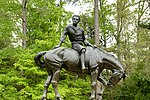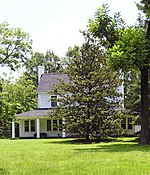Landsford Canal

The Landsford Canal is a navigation channel that opened in 1823 with the purpose of bypassing rapids along the Catawba River to allow efficient freight transport and rapid travel between nearby communities and settlements along the rural frontiers of the era. It had five locks operating over a stretch of two miles (3.2 km) with an elevation change overall of 32–34 feet (9.8–10.4 m). It was part of the inland navigation system from the 'Up Country' to Charleston, built systematically from 1819, and the navigations are today the centerpiece of Canal State Park: The Canal State Park consists of three sets of locks, a mill site, miller's house, and a lockkeeper's house—all in various forms of decay and ruins. The Landsford Canal was the farthest upstream of a series of river boat navigations built in the 1810s and 1820s by Irish masons under the direction of master contractor Robert Leckie of Scotland – canals built on the Western North Carolina Catawba River and South Carolina Wateree Rivers to provide a direct water route between the upstate settlements and the towns along the Fall Line; river transport being far superior to road transport on the crude, oft muddy tracks that sufficed as roads. It is along a two-mile (3.2 km) stretch of the Catawba River in Chester County and Lancaster County west of Lancaster where the fall of the river created a shallow water crossing, a ford named for an early settler who owned the land around the Catawba River, Thomas Land. The lock keeper's house and the canal with three locks is the centerpiece of the Landsford Canal State Park.
Excerpt from the Wikipedia article Landsford Canal (License: CC BY-SA 3.0, Authors, Images).Landsford Canal
Trail,
Geographical coordinates (GPS) Address Nearby Places Show on map
Geographical coordinates (GPS)
| Latitude | Longitude |
|---|---|
| N 34.778888888889 ° | E -80.877777777778 ° |
Address
Trail
Trail
South Carolina, United States
Open on Google Maps






